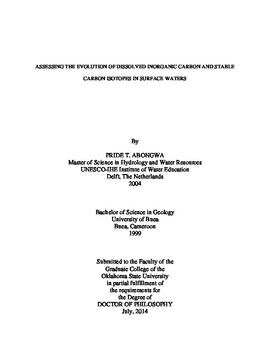| dc.contributor.advisor | Atekwana, Eliot Anong | |
| dc.contributor.author | Abongwa, Pride Tamasang | |
| dc.date.accessioned | 2015-06-17T20:04:20Z | |
| dc.date.available | 2015-06-17T20:04:20Z | |
| dc.date.issued | 2014-07 | |
| dc.identifier.uri | https://hdl.handle.net/11244/14676 | |
| dc.description.abstract | Documenting the transformation of dissolved inorganic carbon (DIC) during the interaction of surface waters with atmospheric CO2(g) is vital for understanding carbon cycling. We conducted field and laboratory experiments that mimic the continuum of changes in DIC concentrations and stable carbon isotope ratio of DIC (delta^13CDIC) over space and time. At partial pressures of CO2 (pCO2) greater than atmospheric, the DIC concentrations decreased due to CO2 outgassing accompanied by continued enrichment in delta^13CDIC. Over time and space, as the pCO2 approaches equilibrium with atmospheric CO2, the DIC concentration increases by evaporation. The outgassing of CO2 and the continuous exchange of carbon with atmospheric CO2 would drive the surface water to equilibrium conditions through kinetic and equilibrium isotopic fractionation. In surface water systems such as carbonate springs that evolve to calcite saturation, significant delta^13CDIC enrichment that occurs after calcite supersaturation is dominated by equilibrium isotopic effect, despite conditions conducive for calcite precipitation. We hypothesize that the chemical and isotopic behavior observed for the field and laboratory experiments may characterize other carbonate-rich waters (streams and lakes) evolving in contact with the atmosphere. Addition of precipitation to surface water dilutes solutes and DIC according to the dilution proportion causing differential evolution of the delta^13CDIC. Continuous invasion of CO2(g) into surface water forms carbonic acid and causes the preferential incorporation of the heavier 13CO2 into the liquid phase causing the surface water to be enriched in delta^13CDIC. The effect of precipitation on surface water is important from the initial stages of dilution to the equivalence of about 10 hour of reaction time based on the results of this experiment. We suggest that experimentation designed to study carbon evolution in surface waters while minimizing carbon evolution based on the effect of dilution should wait for at least 10 hours after a precipitation event before sampling. | |
| dc.format | application/pdf | |
| dc.language | en_US | |
| dc.rights | Copyright is held by the author who has granted the Oklahoma State University Library the non-exclusive right to share this material in its institutional repository. Contact Digital Library Services at lib-dls@okstate.edu or 405-744-9161 for the permission policy on the use, reproduction or distribution of this material. | |
| dc.title | Assessing the evolution of dissolved inorganic carbon and stable carbon isotopes in surface waters | |
| dc.contributor.committeeMember | Quan, Tracy Michelle | |
| dc.contributor.committeeMember | Puckette, James O. | |
| dc.contributor.committeeMember | Halihan, Todd | |
| dc.contributor.committeeMember | Wilson, Gail W. T. | |
| osu.filename | Abongwa_okstate_0664D_13549.pdf | |
| osu.accesstype | Open Access | |
| dc.type.genre | Dissertation | |
| dc.type.material | Text | |
| dc.subject.keywords | dissolved inorganic carbon | |
| dc.subject.keywords | evaporation | |
| dc.subject.keywords | isotopic fractionation | |
| dc.subject.keywords | stable carbon isotopes | |
| dc.subject.keywords | surface water-atmosphere interaction | |
| thesis.degree.discipline | Geology | |
| thesis.degree.grantor | Oklahoma State University | |
